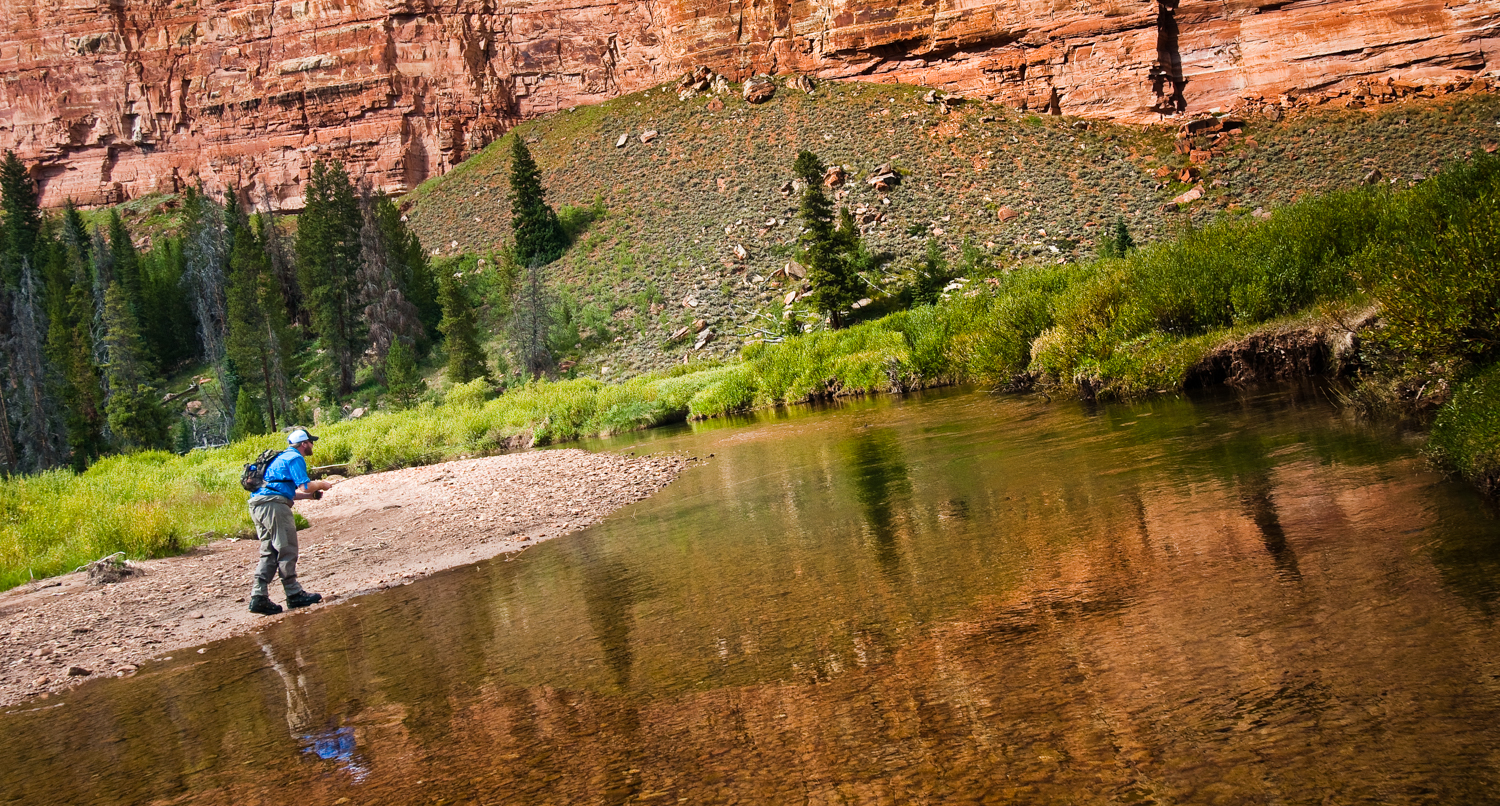
Louis Cahill Photography
By Jason Tucker
I started out writing a piece about stream structure, but the subject is too broad to cover at one setting, so we’re breaking it up into three important, but related categories- Substrate, Fluvial Structure, and Debris and Bankside Structure.
There is so much overlap in these categories, that I understand if you disagree with where I classify certain subjects. I had to put them somewhere.
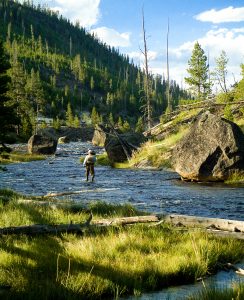 The first thing we need understand about streams is the substrate– what is the bottom made of, and how do the fish and their prey relate to it?
The first thing we need understand about streams is the substrate– what is the bottom made of, and how do the fish and their prey relate to it?
Second is fluvial structure. This includes holes and tailout, outside bends, runs etc. The fish occupy these features differently and thus we fish each of these very differently.
Third are “external” structures. Things like woody debris, beaver dams and houses and even grassy banks. Grassy banks could possibly be considered a fluvial feature, but they also are created by an external influence, the effects of the grass colonizing the riverbank.
Sand.
Sand is the least interesting feature in any trout stream. It has the least interesting bottom, nurtures the least amount of aquatic life, and provides the least amount of cover. And yet a lot of brook trout streams in the north consist of miles of sand substrate. Not only that, but the margins of sandy streams often consist of marl and muck, which host marl and muck dwelling mayflies like Hexagenia limbata and Brown Drakes. They also host large populations of tricorythodes mayflies, so sand itself does not preclude trout by any means.
What it means is that trout will relate to surrounding structure and cover more than to the bottom. It’s in these sandy stretches that you’ll find fish feeding midstream early and late, and moving closer or into the tag alders or other bankside brush as the sun hits the water. This is kind of a general pattern anyway, and there’s some major exceptions I’ll discuss elsewhere, but it’s especially true of sandy areas.
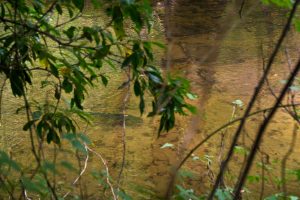
Louis Cahill Photography
One advantage of sand is that fish can be highly visible over sand. The disadvantage is that they know this too and may be extra sensitive to disturbance. It can make for some challenging sight casting for sure. When sandy streams drop clear and bright in summer it can be some of the most trialsome fishing of the year, with fish darting for cover at first sight of your fly line overhead, or the moment your fly touches the water.
Boulders.
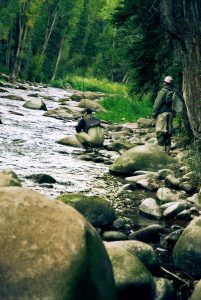
Louis Cahill Photography
Brook trout like to hang out behind boulders waiting for food to sweep past. If you can get your fly to hang out behind it so much the better. Boulder beds are pretty good places to swing a soft hackle or a small streamer. Big fish like to hang out around boulders placed in the bank for erosion control on outside bends. While boulder bed rapids are very common in mountain streams in Appalachia in the Eastern US, and the Rocky Mountains of course, they are surprisingly common in the glacial outwash streams in Northern Michigan where I’m from.
Boulder beds tend to be some rough wading and fishing. They’ll hold fish, sometimes some good ones depending on the situation. A lot of boulder beds occur in rapids between pools. This is pocket water and can be a lot of fun to pick apart. I have caught some very nice fish in these even though I was initially skeptical they are worth fishing at all. With a dry dropper rig you’re trying to hit the individual fish holding spots. You want to hit the deeper pockets between and behind boulders. You also want to target the slower areas next to the ripping fast currents. I also like to swing muddler minnows through them and watch what happens.
Gravel.
Trout prefer a gravel substrate over all others. This may be because their camouflage works best over gravel. Gravel bottoms also produce some surface chop to help fish hide. It holds a lot of gravel dwelling insects, more than sand. If you are fishing a sandy stream pay attention wherever you find gravel. Chances are there will be more and bigger trout there. If you can find a gravel seam in a stained-up hole in a tiny stream I guarantee you there will be a good fish on it. Some streams consist of many miles of gravel and are excellent fishing. Others, such as sand or mountain streams, may only have limited sections interspersed by longer stretches of sand, bedrock or boulders. Be sure and concentrate your efforts wherever you find gravel on these stream types. The fish will be concentrated there as well. When fishing mountain streams sometimes you will find a single plume of gravel extending through a hole or run. Concentrate your efforts there. It will pay off.
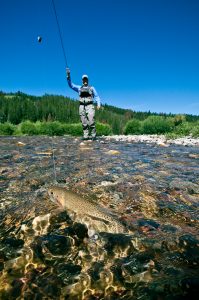
Louis Cahill Photography
Mountain streams merit an entire chapter as far as sorting out cover and bottom types. Cover ranges from overhanging rhododendrons to overhanging rock ledges. Woody debris too, but not as many of the log jams you find in lowland northern streams. Mountain streams tend to sweep away woody debris which makes them friendlier for nymphing and dropper rigs. Bottom types range from sand to bedrock. Sand is probably the least common bottom type, with the balance split between bedrock, gravel, and boulders. The near constant presence of cascades, rapids and waterfalls can also provide varying amounts of cover and feeding zones.
Since sand makes up very little of most mountain streams (it flushes out constantly during high water) bedrock tends to be the least productive bottom type. A bedrock rapid will hold less fish than a boulder rapid. Shallow flat bedrock will only hold fish if there is whitewater or chop overhead. Deeper bedrock that has channels cut parallel to the current will hold fish, especially if some gravel has gathered in the cuts.
Muck and Marl.
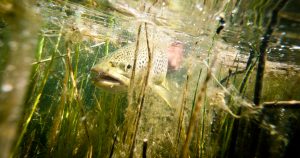
Louis Cahill Photography
Muck and marl are two highly productive substrate types not to ignore. They are often associated with slower, warmer water. Many lakes in Northern Michigan consist of a marl bottom with muck margins. The muck is in habited by (among others) massive numbers of Hexagenia limbata and atracaudata mayfly nymphs. The marl is inhabited by similarly large numbers of Brown Drake nymphs (Ephemera simulans). Therefore, muck and marl are often associated with the lower reaches of lowland streams, and slower stretches of water. These are highly productive habitats that produce massive amounts of food that exist at the upper end of the acceptable temperature range for trout. This is what makes Michigan’s Au Sable River such a productive stream and trophy fishery. Many miles of it seem more like a slow flowing lake than a river, and huge trout hang out in these stretches sipping hexagenia mayflies all night long in the summer.
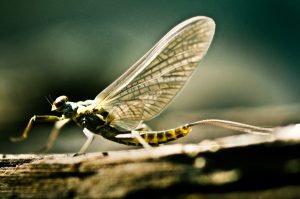
Louis Cahill Photography
You will find some muck and marl scattered in the upper stretches of streams and these will host spotty hatches of the big mayflies. It can be fun to go set up on a small stream in mid to late June in the evening and wait for these flies to hatch. You may see or even catch the biggest trout in the stream, bigger than you thought could live there. Hatches of the big flies on small streams can be highly localized, and some local knowledge can be key. There are a very few small streams out there that consist mostly of muck and marl, are spring fed, cold, and deep, and host large hatches of mayflies. If you know or have access to one of these, by all means fish them. They hold large numbers of huge trout, and are often a local secret. The ones I’m thinking of flow mostly through farmland and access is hard to come by. These are the unicorns of small stream fishing. Exploring the lower ends of any small trout stream that feeds into a marl lake can yield big results.
Stay Tuned for the Next Installment!
Jason writes the fine blog Fontinalis Rising
Jason Tucker
Gink & Gasoline www.ginkandgasoline.com hookups@ginkandgasoline.com Sign Up For Our Weekly Newsletter!
Wonderful breakdown of substrates. Very useful!
Pingback: Georgia Fishing Report: May 22, 2020 | Georgia Wildlife Blog
Great article! One question: I know what “muck” is, but could you define what “marl” is, not sure what you mean by that?
A marl bottom is soft, silty mud.